For anyone asking, upon arrival in Europe, to see the most stunning sites of the Alps, the Dolomites (Dolomiti in Italian) will certainly be one of the top three. This majestic mountain range located in northeastern Italy highlights an amazing land of adventure. The Dolomites are renowned for both winter sports enthusiasts and mountaineers: Val Badia (Gadertal), Gherdëina (Val Gardena / Grödental) and Anpezo / Ampezzo are the most famous areas… but cycling enthusiasts also follow the “Giro d’Italia”: Passo Gardena, Passo Pordoi, and Passo Sella. If you like hiking among peaks, walls of mountains, towers, canyons, and vast plateaus all overlooking a landscape of pastures, forests and deep valleys… then you will be overwhelmed. Everyone can find happiness here: the opportunities are so numerous. The famous architect, Charles-Édouard Jeanneret-Gris, better known by his pseudonym “Le Corbusier” described this mountain range as “the most beautiful architectural work in the world” ?

The Sassolungo
In the northeastern part of Trentino-Alto, a scenic road winds its way through the Val di Fassa, surrounded by some of the most important majestic massifs in the Dolomites: the Marmolada, the Sella group, the Sassolungo and the Catinaccio group. The River Avisio (La Veisc in Ladin language), a tributary of the Adige, runs through the middle of the valley. One can walk along it or simply sit beside it while listening to “« La voce del torrente: L’acqua bisbiglia / sussurra sommessa / struscia le rive frusciando lieve / mormora e chiacchiera / borbotta piano / trattiene il fiato, poi corre ridendo…“. Seven municipalities are scattered across this magnificent valley: including the village of Canazei at 6,043 feet above sea level, the capital of the Val di Fassa located about 68 miles northeast of Trento. It is not only a summer holiday resort, but especially a winter resort because it is situated along the route to most prestigious ski resorts of the Dolomites. The Canazei is relaxing: woods, alpine pastures offering landing areas for paragliders, magnificent chalets with flower-bedecked balconies, a shingle-roofed church with a characteristic onion-domed bell tower, and of course the most beautiful peaks of the Dolomites. In summer, hiking, cycling, paragliding, and climbing along a via ferrata are some of the most popular sports. The Val di Fassa has another charming attraction: it is the only valley in Trentino where the inhabitants speak Ladin, more precisely Ladin dolomitan. The only other areas where this language is spoken are the valleys of Gardena and Badia in the Alto Adige and the valley of Livinallongo in the Veneto. In the Val di Fassa 82.4% of the inhabitants declared Ladin as their native language for the 2001 census. But you probably wonder what this obscure language is ? The Ladin (or Ladino in Italian) is a Romance language and part of a unitary Rhaeto-Romanic language similar to Swiss Romansh and Friulian… In the course of its history, Ladin was been replaced by German and Italian as the main language of the region, but some villages resist the German-Italian invader and proudly fly the blue (like the sky), white (like snow) and green (like meadows) flag. Do not be surprised if you see that the rest stop you are heading to is called “Rifugio“, “Hütte” or “Ütia“… Ladin is recognized as a minority language in 54 municipalities of South Tirol, Trentino, and Belluno and recognized by the European Union thereby guaranteeing its use in schools, administration, justice and media. The newspaper “Dolominten” publishes, for instance, a few weekly pages in Ladin while the radio station RAI (Radiotelevisione Italiana) broadcasts 4h30 per week in Ladin. Finally, customs of Ladin speakers are still carefully preserved: relating to this culture are still very important: traditional practices related to carnival as well as wood carving… and splendid folk art.
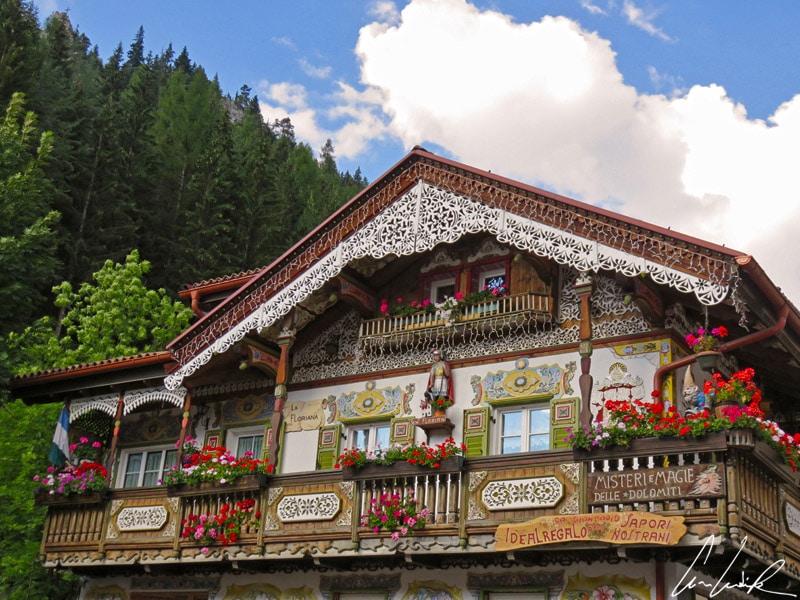
Canazei and its magnificent chalets with flower-bedecked balconies
But back to our hiking paradise. Registered as a World Heritage Site by UNESCO in June 2009, the Dolomite massif contains many marked long-distance paths, suitable for hikers of all levels. These trails are called Alte Vie (High paths) and numbered from 1 to 8. At the origin of this formidable network of trails are, of course, the muleteer trails used by smugglers and peddlers and also the Via Ferrata created by soldiers during the Great War (1914- 1918). It is difficult to remain indifferent to vestiges of former observation posts and sniper hideouts audaciously placed in the verticality of these natural walls, Géantes ces murailles bâties de pierres et de sang / Plus hautes que les batailles, défiant le poids des ans (Giant walls built of stones and blood / higher than the battles, defying the weight of the years), lyrics from Les Murailles by French singer Jean-Jacques Goldman. From the Col Rodella (8,100 feet), we see the magnificent panorama of the Sassolungo (10,427 feet) or “long rock“. This emblematic mountain consists of a rocky pyramid flanked by a dozen peaks between 9,131 and 10,427 high. The trail runs along these sharp summits, which create a sawtooth profile off of which light reflects with dazzling intensity. These bare peaks with steep walls rise like stone soldiers defying the sky. Curious as you are, you wonder why the Dolomites, in contrast to the rest of the Alpine chain, reflect sunlight so powerfully ? More than just a mountain range, this massif is a treasure trove of fossils from the Mesozoic era and a geological curiosity… Formerly called “Monti Pallidi” (Pale Mountains), the current name (Dolomites) comes from “dolomite“, a limestone rock of marine origin that was named in homage to Deodat Gratet of Dolomieu, a French geologist of the 18th century who was the first to study it. About 250 million years ago, the Dolomites were nothing but a cluster of shells, coral and algae engulfed at the bottom of the Thetays (a paleo ocean). With the movement of tectonic plates, mountains first emerged then time and erosion sculpted them to forge their distinctive sharp profile. The dolomite rock gives the mountains a particular white color, hence their former name “Pale Mountains”. However, at dawn or dusk the rocks reflect “the enrosadira” (reddish color). From white to pink, these limestone cliffs are adorned with reddish hues, which give them an unreal surface.
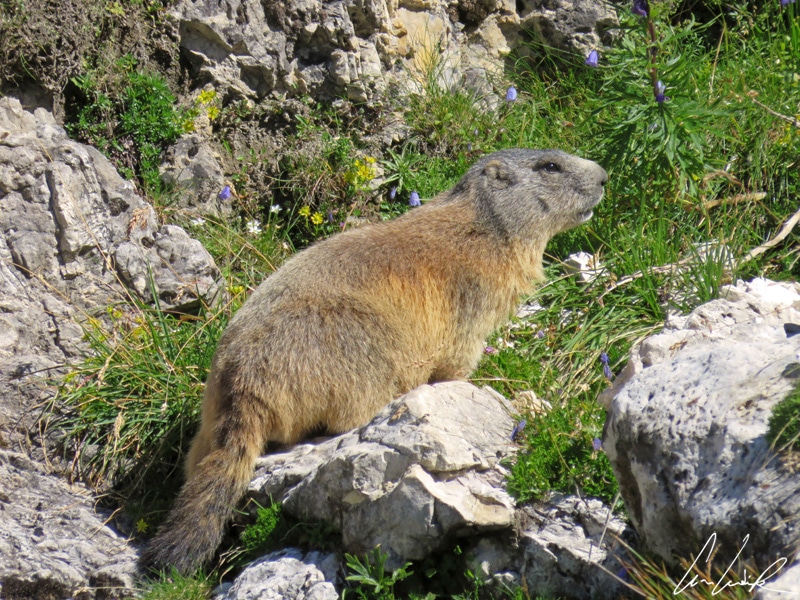
Marmot
Summers are mild and rainy and the numerous alpine pastures green. In the heart of the Dolomites mountain range, the Alpe di Siusi is the largest high altitude Alpine meadow in Europe, covering an area of about 22sq2 at about 6,069 feet. Water and grass in abundance make it a paradise for herds of horses, Grioggio Alpina, and Highland cows with impressive hairs and horns. The livestock provides butter and cheese, which are used abundantly in cooking. Do not miss the “pestolato”, a cheese scented with pepper and grappa… These green meadows are dotted with multicolor flowers, elegant edelweiss, columbine of the Dolomites, black nigritelle (a small orchid with a vanilla scent), alpine carnations, alpine Yarrow, gentian of the Dolomites, etc. Suddenly, I sense movement and turn instinctively, but see nothing. Scrutinize the surroundings more closely…, I spot a marmot perched on a rock a short distance away (perhaps the local Groundhog Day ?) With its light brown fur coppery black, it melts into the rocks, and almost passes unnoticed. For Mountain lovers, only a single day spent on this Alpine massif is enough to fall under its mysterious charm. A charm coming from the contrasting emerald green of the forests and the pink of the rock? Or from the contrast between the relief of green meadows, gently sloping and sprinkled with flowers, and rocky spurs with steep walls emerging from the mists ? It is not so much the height of the Dolomites that is impressive, but their aesthetic, sharp and easily recognizable. According to the Italian mountaineer Reinhold Messner, also known as the “King of the Eight thousand” and conqueror of the highest mountains on the planet, “These are not the highest, but they are certainly the most beautiful mountains in the world“. So, like, this native, let’s stop thinking about our problems and take the time to admire the rocky walls of the Pale di S. Martino, to feel the freshness of a stream that running down the rock face, to enjoy the reflection of the landscape on the surface of the Lèch di Cavia or simply to feel the pleasure of discovering the Lèch de Gereburt at the turn of a path. In a word “Slow down” and savor the purity and the silence of this enchanting place !
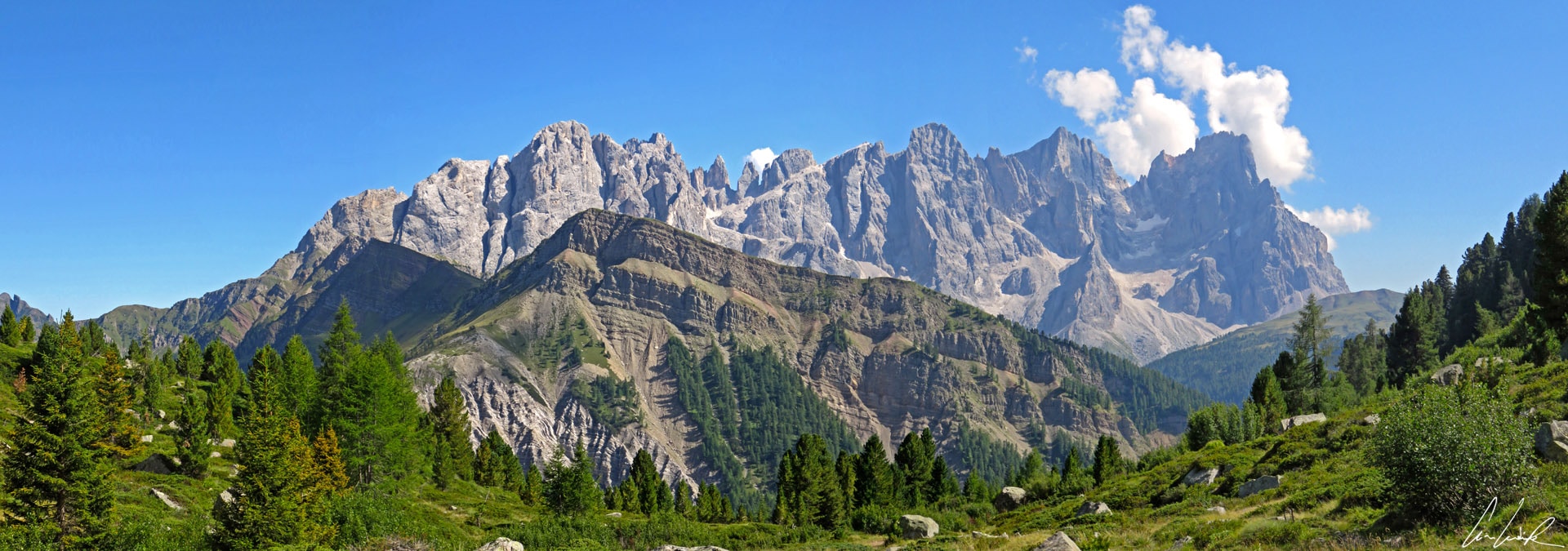
Pale di S. Martino
The Pordoi Pass at 7,346 feet above sea level, is the highest pass of the Dolomites and connects the Val di Fassa to the Cordevole valley. Pordoi Pass is located between the Sella in the north and the Marmolada group in the south. It is a large green area that stretches all away up to impressive blocks of rocks with vertical walls and truncated summits. The ascent to the Sass Pordoi (from 7,356 to 9,730 feet), between these solemn towers or crenelated ruins, is arduous but splendid. Here the mountain reigns sovereign, with its walls of limestone and its carpets of stone without end. The hiking trail arrives just below the cable car, and the mineral desert that we discover is both mysterious and enchanting. From the top, the view embraces the Groupo del Sella and also the Sassolungo and the Marmolada. The Marmolada, the highest peak of the Dolomites is also known as the “Queen of the Dolomites” and stands 10,968 feet high. The name Marmolada may be derived from either the Latin “marmor,” meaning marble, or from an Indo-European root “marmar,” meaning “shining.” Both words refer to its glacier. The relief of dizzying walls, a plateau and moonlike landscapes strongly inspired the Italian novelist Dino Buzzati for whom the mountain was, “the perfect symbol of the supreme tranquility“. Buzzati accompanied by his guide Gabriele Franceschini spent every September in the Dolomites after the mass of tourists had departed. He used his memory of these sites to set the scene for his novels and short stories. Thus, for those who know how to read between the lines, the Dolomites always appear in the end. Dino Buzzati was inspired by the landscapes of the Dolomites to describe the vast desert that stretched in front of a young officer, Lieutenant Drogo, the main character in “The Tartar Steppe” (Il Deserto dei Tartari) published in 1940, “And it was then that he seemed to see the yellow walls of the courtyard of the fortress soar up toward the crystal sky, while, above them and beyond, higher and ever higher, snow-topped bulwarks rose obliquely in solitary towers, tiny redoubts and airy fortifications he had never noticed before“.

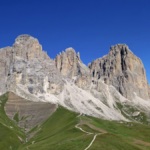
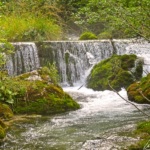
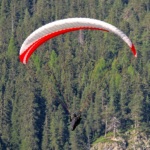

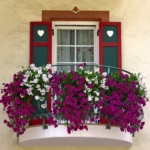
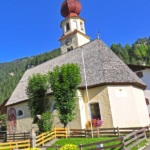
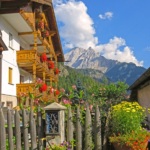


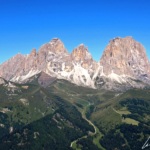
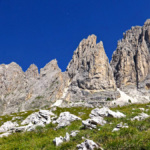
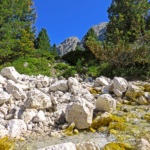
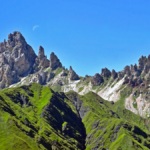
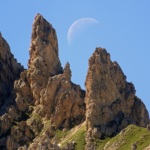
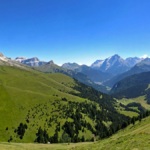

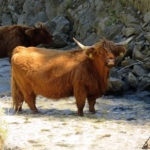




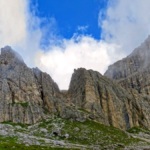
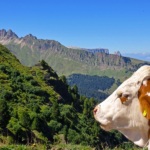





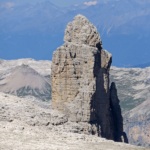
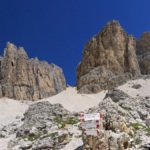
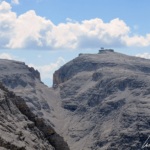


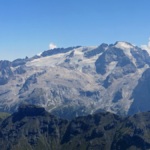


The Dolomites have been on my list for years now and every time I see photos of them, or read tales of explorers wandering their paths I always melt! I hope to get there one day and don my hiking shoes and experience them for myself!
This mountain region is rich in culture and enchanting beauty where traditions are maintained and nature is highly respected and preserved. This area is really peaceful and relaxing. And the Dolomites have a network of stunning mountain trails 😉
I want to go so bad!!
This region is full of so many amazing places to see, great people to meet, delicious food to eat So you should see the Dolomites by yourself at least once 😉
Beautiful photography. I love the little marmot, how cute! I also love the quote about not being the highest but the most beautiful – I always like the underdog. It’s not all about being the highest/biggest/most popular etc 🙂
Though certainly not unknown, the Dolomites are often overlooked on Italian itineraries… If you do love mountains a visit to the Dolomites provides some of the most beautiful you’ve ever seen 😉
Such pretty pictures! The marmot is super cute!
This mountain region is beautiful and nature is highly respected and preserved 🙂
Wow they are beautiful!
The Dolomites are really stunning !
I’ve been wanting to see these for years! Very beautiful!
In a region as spectacular as the Dolomites, you want to be able to focus on what matters most: the amazing views, incredible food and abundant activities on offer 🙂
Wow! This is stunning. I love all of your photos. Seriously breathtaking. This sounds like such a great trip.
Come indulge your senses, while photographing one of the world’s most scenic regions – the Dolomite Mountains – crown jewel of the Alps 😉
I’ve lived in Italy on and off for four years now and have yet to make my way up north to the Dolomites! Its so insane to me to think about what they were like 250 million years ago… what a cool thing to think about! Thanks for the wanderlust inspiration, dear! xx
From the rocky peaks of the mountaintops to the evergreen lakes that sparkle below, the Dolomites are like a movie scene come to life 🙂 which started 250 million years ago.
I love the Dolomites! I was marveling at them when visiting Bolzano and surrounding towns. They are such an impressive massive. I’m not much for hiking, but even looking at them has its charm 😉
This is one of few places in the world where quality and quantity go hand in hand. The peaks and valleys are dotted with rifugi – mountain huts offering local fare that will never leave you hungry or unsure where to find lunch 😉
I love South Tyrol – the Italian mountains are some of my favourites; even more beautiful than Austria I think (and that’s where I’m from )! Your photos are beautiful – really make me want to go back!
Though certainly not unknown, the Dolomites are often overlooked on Italian itineraries. If you do love mountains a visit to the Dolomites provides some of the most beautiful you’ve ever seen !!
Wow! This place is outstanding for hiking! When’s the best time of the year to visit it?
The high season for the Dolomites runs from late June through the end of August for hikers and cyclists. September and October means relatively nice weather and fewer tourists. The mountains are still free of snow so you can access the trails and have a little more elbow room while you hike since there aren’t as many people to share the trails with. Pricing for hotels and activities tends to be cheaper as well 🙂